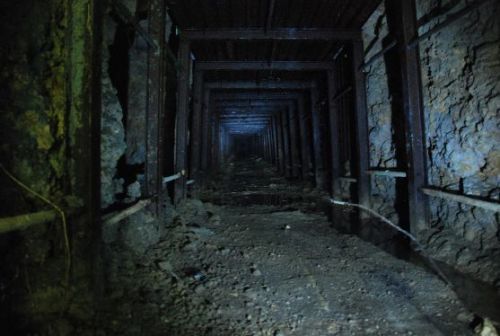More call for 32nd Army headquarters trenches under Shuri Castle to be opened to the public as castle is rebuilt

The inside of the 5th tunnel of the 32nd Army headquarters trenches. Much reinforcement work has been done, but signs of weathering are still apparent; photograph from June 2015
December 1, 2019 Ryukyu Shimpo
While support grows for the reconstruction of Shuri Castle after it was destroyed in a fire, more are also calling for the underground trenches used as the Japanese 32nd Army headquarters to be opened to the public. Eiki Senaha, 91, of Naha, who is the former president of Meio University and decided on the public opening of the trenches as chair of the prefectural 32nd Army Headquarters Trench Preservation and Opening Investigation Committee in 1996, is one such person. “Shuri Castle and the headquarters trenches have an inseparable relationship,” said Senaha, once more emphasizing the necessity of opening the headquarters trenches in conjunction with rebuilding the castle.
Opening of the 32nd Army headquarters trenches was proposed by former senior analyst for the Ministry of Foreign Affairs Masaru Sato in a column for this newspaper, and more are expressing their agreement to the proposal.

Eiki Senaha discussing the necessity of opening the 32nd Army headquarters trenches to the public, on the afternoon of November 29 in Naha
The Okinawa prefectural government, considering the headquarters trenches to be a symbol for the Battle of Okinawa, began a full-scale survey of them in 1993. The Preservation and Opening Investigation Committee, of which Senaha, then a Meio University professor, served as chair, was established in November 1995, and the following year, 1996, the committee decided that the trenches should be opened to the public. Thereafter, a Basic Plan Investigation Committee planned to go so far as opening to the public the room of General Mitsuru Ushijima.
However, from the start there were concerns about the danger of collapse and the extensive costs that would be required to prepare the trenches for opening, and they have yet to be opened to the public. At the time the decision was made, Senaha himself entered the trenches through the 3rd tunnel and observed General Ushijima’s room, reporting that there were hypodermic needles on the ground inside. However, he says that inside “there was water flowing, and I knew that it would be infeasible to open the trenches to the public in that state.”
Shuri Castle has been burned down four times, once of which was in April 1945, right in the middle of the Battle of Okinawa. This was because headquarters trenches were built directly underneath the castle, which had been designated a national treasure, and it was therefore targeted by the U.S. military. “The headquarters trenches are critical in explaining Shuri Castle,” explains Senaha. “They also help us convey the true history of the Battle of Okinawa.”
Hojun Kakinohana, 86, of Naha, who represents the Okinawa Peace Walking Association, a group that explains the Battle of Okinawa through re-experience, says that it should be the national government’s responsibility to prevent the headquarters trenches from collapsing and turn them into a “cornerstone of peace.” “I want people who come to see Shuri Castle to know about them,” says Kakinohana.
■Japanese military bases were targeted by the U.S. military during the Battle of Okinawa
Construction of the 32nd Japanese Army headquarters trenches began in December 1944, with the trenches to serve as the headquarters of the 32nd Army established by the Japanese military as an Okinawa garrison under direct control of the Imperial General Headquarters. The trenches served as a military center for the Japanese military until it retreated to the south in May 1945.
The trenches comprise five tunnels, and include the “rooms” of 32nd Army General Mitsuru Ushijima and Lieutenant General Isamu Cho and an officers’ room. Since the trenches were built directly underneath Shuri Castle, a national treasure, the castle was targeted by the U.S. military in the Battle of Okinawa and was burned to the ground in April 1945. The grounds were the site of a vicious battle between the Japanese and U.S. militaries, and many civilian lives and cultural assets were lost.
An explanation board is posted near the entrance to the first tunnel of the headquarters trenches, near the Sonohyan-utaki stone gate at Shuri Castle, but the prefectural government, in the written explanation prepared by the Explanation Board Installation Investigation Committee in 2012, removed mention therefrom of “comfort women” and massacre of civilians by the Japanese military. There has been disagreement, including some committee members calling for those topics to be reintroduced in the explanation board.
(English translation by T&CT and Sandi Aritza)
Previous Article:A protest in its 16th year, and a teenager’s vision to “protect the future”
Next Article:Okinawans host Eisa dancing event in Indonesia in support of Shuri Castle
[Similar Articles]
- OPG to form committee of civil engineers and other experts to look into opening 32nd Army underground trenches to the public
- Group submits proposal to preserve the 32nd Army Headquarters Shelter as a “peace education site,” Okinawa’s vice governor will look to discuss at investigative commission
- OPG to set up an explanation board about the former 32nd Army Headquarters Shelter at Shuri
- Basic Repairs on the Dragon Pillars which Remained Standing After the Fire at Shuri Castle
- Kurayoshi Takara gives lecture on Shuri Castle restoration effort in Naha
 Webcam(Kokusai Street)
Webcam(Kokusai Street)


